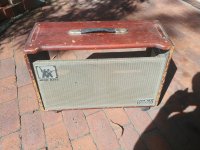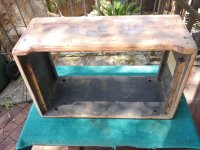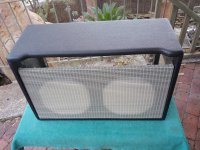Technics M215 cassette deck. Had a really short power cord, so I changed it and cleaned the tape path up too. Can't wait to get in hooked up [emoji106] parts on the way for that tuner too...then my silver faced early-80s setup will be complete. For now [emoji28]
Sansui G-8000 with an extremely intermittent right channel, plus the expected dirty contact issue. Everything else was very straight forward. The intermittent channel was another story.
The mono switch brought the right channel back, so that eliminates a lot of circuitry. lightly touching the sires from the input jack PCB would bring that channel back, but touching everything would result in the same. It turned out to be an untrimmed lead from the factory shorting across to the hot signal side. De-soldered it, bent the lead upand trimmed, then re-soldered it. That fixed it.
I bet this thing drove technicians nuts over the years.
-Chris
The mono switch brought the right channel back, so that eliminates a lot of circuitry. lightly touching the sires from the input jack PCB would bring that channel back, but touching everything would result in the same. It turned out to be an untrimmed lead from the factory shorting across to the hot signal side. De-soldered it, bent the lead upand trimmed, then re-soldered it. That fixed it.
I bet this thing drove technicians nuts over the years.
-Chris
I have spent hours trying to fix an intermittent amp only to find in the one end of a resistor end wasn't soldered. It was touching the via most of the time so sometimes worked. I found twisting the pcb gently would make it work or not work.
I bet this thing drove technicians nuts over the years.
-Chris
A good first move when fixing any amp is a careful visual inspection.
I have fixed quite a few without even powering them up or getting a meter out.
It turned out to be an untrimmed lead from the factory...… only to find in the one end of a resistor end wasn't soldered.
I'm surprised at the number of these I have found and fixed over the years. It was most prevalent during the days of hand PTP assembly, but I have found several cases of wave soldered PCB stuff with a perfectly unsoldered lead or two. Many have been in high $$$$ HP and Tektronix test equipment.
My own personal TEK2232 has an intermittent buried deep inside it somewhere. I purchased it cheap from a scrap sale complete with a "DEAD" sticker on it. I was planning to rip it apart and fix it, but was pleasantly surprised to find that it works...….except when it doesn't. For well over 20 years I have been smacking it as necessary, but some day I know that my luck will run out.
I was given a Traynor tube guitar amp head back in the 80's because it would break into random fits of screaming, often at the most inopportune moments, like when it was being used in a live stage performance, often outdoors at full volume. It had been taken to a shop several times, and I had been through it myself. In almost every case the problem could not be reproduced in the shop. The owner got frustrated and bought a new amp, giving me the Traynor. My plan was to strip it to reuse the cabinet and chassis, which I did. Upon teardown, and well past the point of no return, I found the real problem. A wire from the turret board, or PCB, I don't remember which, had been carefully wrapped through a lug on one of the pots, but never soldered. This was not visible without complete disassembly.
I built up one my own design valve amps.
It was 12ax7 front end, into 12au7 phase splitter into 4 off EL34 valves.
Powered it up and after a little while one of the El34's red plated.
I had a good look around and found I had completely missed fitting a grid stopper on the red plating EL34 valve.
Pays to visually inspect carefully before powering up.
It was 12ax7 front end, into 12au7 phase splitter into 4 off EL34 valves.
Powered it up and after a little while one of the El34's red plated.
I had a good look around and found I had completely missed fitting a grid stopper on the red plating EL34 valve.
Pays to visually inspect carefully before powering up.
I have been smacking it as necessary...
Side note:
My car had increasing switching hash through the speakers over time. Bad ground?
So I google the problem to find the "solution" was to slam the glove box.
It worked though.
Percussive maintenance -- the art of fixing something by hitting it.
Waves L2 Ultramaximiser
AKG C4000B Condenser Mic
Rode NT1 Condenser Mic
PDX PCM1704 / Valve DAC
TL Audio C-2021 valve compressor
Marshall AFD100 (micro controlled power scaling and autobias)
Small 15W (2 x EL84) Gita amp
Marshall JVM 410H
Arion Tube / Class D hybrid Power amp
Matrix 1600 watt amplifier (2 x 800W switchmode PS / MOSFET OP stage)
Neve AM3631 (2 x 1081 channels strips)
Lexicon PCM80 (digital reverb)
Fender Blues Junior
Telectronix LA4 compressor (x2)
Eventide H8000 FX Unit
DBX 160 compressor
I'll stop........
But the most rewarding job recently was building a D*mble Overdrive Special
Amplifier Clone from ground up and restoration of an old Music Man HD130.
Cheers
TCD
AKG C4000B Condenser Mic
Rode NT1 Condenser Mic
PDX PCM1704 / Valve DAC
TL Audio C-2021 valve compressor
Marshall AFD100 (micro controlled power scaling and autobias)
Small 15W (2 x EL84) Gita amp
Marshall JVM 410H
Arion Tube / Class D hybrid Power amp
Matrix 1600 watt amplifier (2 x 800W switchmode PS / MOSFET OP stage)
Neve AM3631 (2 x 1081 channels strips)
Lexicon PCM80 (digital reverb)
Fender Blues Junior
Telectronix LA4 compressor (x2)
Eventide H8000 FX Unit
DBX 160 compressor
I'll stop........
But the most rewarding job recently was building a D*mble Overdrive Special
Amplifier Clone from ground up and restoration of an old Music Man HD130.
Cheers
TCD
Last edited:
Hi Gregje,
Some times they just go, especially if they are running hot. You could always check the transient start up conditions. It isn't that uncommon to find a designer has exceeded the device specifications briefly during start up or shut down conditions. Parts can sometimes survive that and the odd one will fail at some point. High line conditions can make the problem worse. So can folks who dive in and replace capacitors (recapping) with larger ones. That can extend the time a component has its ratings exceeded.
-Chris
Some times they just go, especially if they are running hot. You could always check the transient start up conditions. It isn't that uncommon to find a designer has exceeded the device specifications briefly during start up or shut down conditions. Parts can sometimes survive that and the odd one will fail at some point. High line conditions can make the problem worse. So can folks who dive in and replace capacitors (recapping) with larger ones. That can extend the time a component has its ratings exceeded.
-Chris
Here's the Music Man.
The electronics didn't require much attention besides a power re-tube and a
little tidying up. The Tremolo circuit didn't work very well as is common and
there are a few secret fixes for these including the dreaded Fender 'tick tick'.
Reverb tank replaced, speakers replaced, front grille replaced, cabinet
sanded/filled/sanded/tolexed.
The electronics didn't require much attention besides a power re-tube and a
little tidying up. The Tremolo circuit didn't work very well as is common and
there are a few secret fixes for these including the dreaded Fender 'tick tick'.
Reverb tank replaced, speakers replaced, front grille replaced, cabinet
sanded/filled/sanded/tolexed.
Attachments
Here's the Music Man.
The electronics didn't require much attention besides a power re-tube and a
little tidying up. The Tremolo circuit didn't work very well as is common and
there are a few secret fixes for these including the dreaded Fender 'tick tick'.
Reverb tank replaced, speakers replaced, front grille replaced, cabinet
sanded/filled/sanded/tolexed.
Thats a work of art!
I own an MCI recording console from the late 70s, the power supplies are all linear an big 4U 19" racks, the supply regulator consists of 2N3055 pass transistors, these get burned every time!, Apparently the new 2N3055s are not as sturdy as the old ones, some have suggested the 2N3055H which apparently can take a beating more gracefuly but are no longer made.
Hi Terry,
Very clean work! I really like what you've done to the piece.
Hi Joe,
If it has plasma meters, those regulators like to blow due to a design defect. It's been years since I worked on one. As for the 2N3055 transistors, they are only good for about 60 VDC I think. You could use an MJ15003 that would do it. 140 VDC instead, but what I was going for was a slow device. An MJ15022 would probably oscillate. An MJ2119x device might oscillate as well.
When looking at breakdown voltages, you have to look at the C-E breakdown, not the C-B ratings which are always the same as C-E or higher. In the case of the 2N3055 I think the C-B rating was 100 VDC. Just checked On-Semi and I'm right on those numbers.
-Chris
Very clean work! I really like what you've done to the piece.
Hi Joe,
If it has plasma meters, those regulators like to blow due to a design defect. It's been years since I worked on one. As for the 2N3055 transistors, they are only good for about 60 VDC I think. You could use an MJ15003 that would do it. 140 VDC instead, but what I was going for was a slow device. An MJ15022 would probably oscillate. An MJ2119x device might oscillate as well.
When looking at breakdown voltages, you have to look at the C-E breakdown, not the C-B ratings which are always the same as C-E or higher. In the case of the 2N3055 I think the C-B rating was 100 VDC. Just checked On-Semi and I'm right on those numbers.
-Chris
Hi Terry,
Hi Joe,
If it has plasma meters, those regulators like to blow due to a design defect. It's been years since I worked on one. As for the 2N3055 transistors, they are only good for about 60 VDC I think. You could use an MJ15003 that would do it. 140 VDC instead, but what I was going for was a slow device. An MJ15022 would probably oscillate. An MJ2119x device might oscillate as well.
When looking at breakdown voltages, you have to look at the C-E breakdown, not the C-B ratings which are always the same as C-E or higher. In the case of the 2N3055 I think the C-B rating was 100 VDC. Just checked On-Semi and I'm right on those numbers.
-Chris
Oddly enough, the PSU that blows out the most is the 5V logic supply, I wil try those MJ15003, thanks for the tip!, my console does have the plasma meters, they are a pain but look sooo pretty!
Hi Joe,
Look at the plasma supply. I think the pass transistor also has a low C-E voltage rating that is exceeded when you power up. Just replace it now before the darned thing goes.
Yes, those displays are very pretty.
-Chris
Look at the plasma supply. I think the pass transistor also has a low C-E voltage rating that is exceeded when you power up. Just replace it now before the darned thing goes.
Yes, those displays are very pretty.
-Chris
Hi Joe,
Look at the plasma supply. I think the pass transistor also has a low C-E voltage rating that is exceeded when you power up. Just replace it now before the darned thing goes.
Yes, those displays are very pretty.
-Chris
Hi Chris, thanks for the advice!, I will certainly replace the transistors in the plasma PSU.
- Home
- Member Areas
- The Lounge
- What did you last repair?



